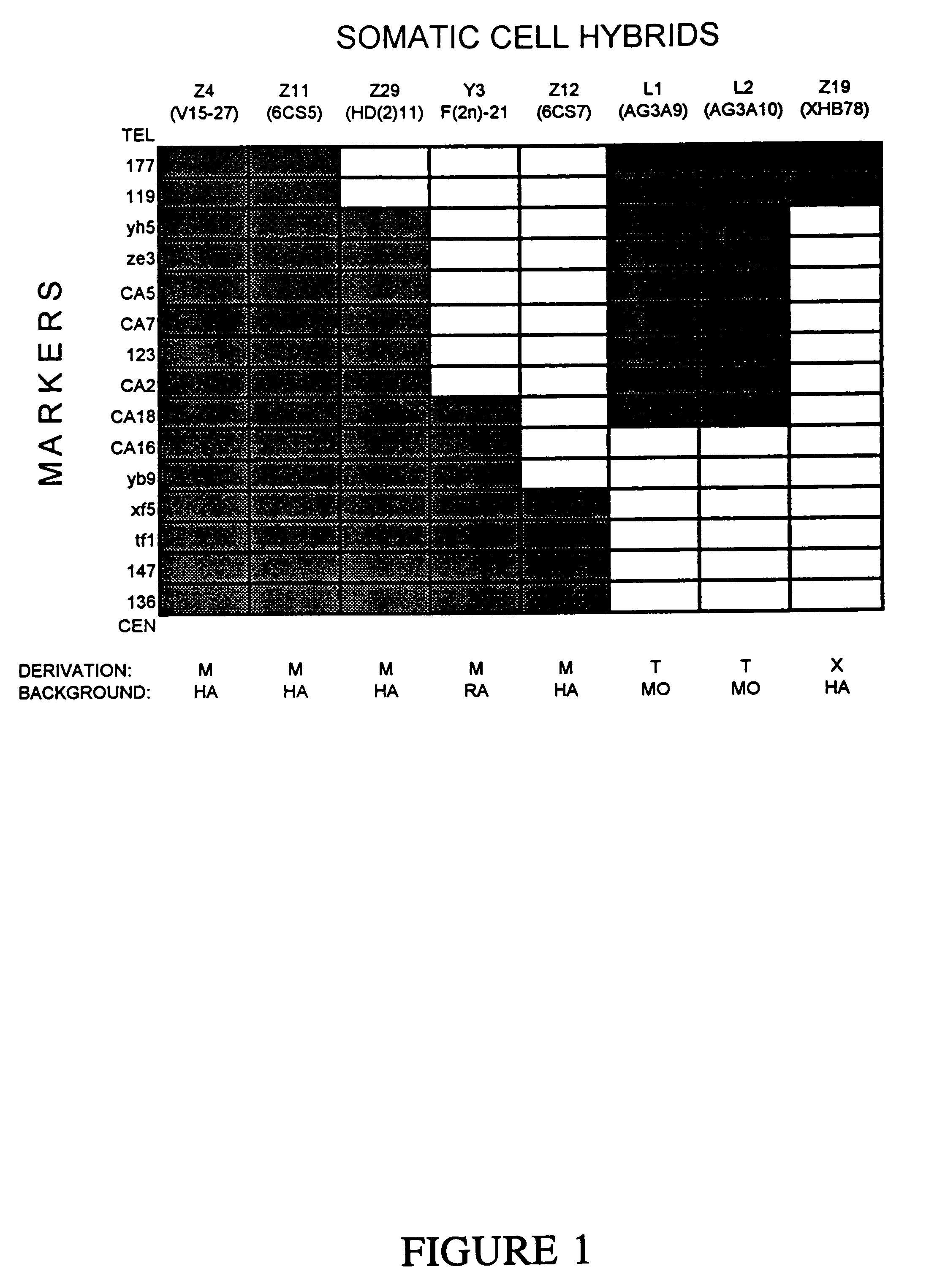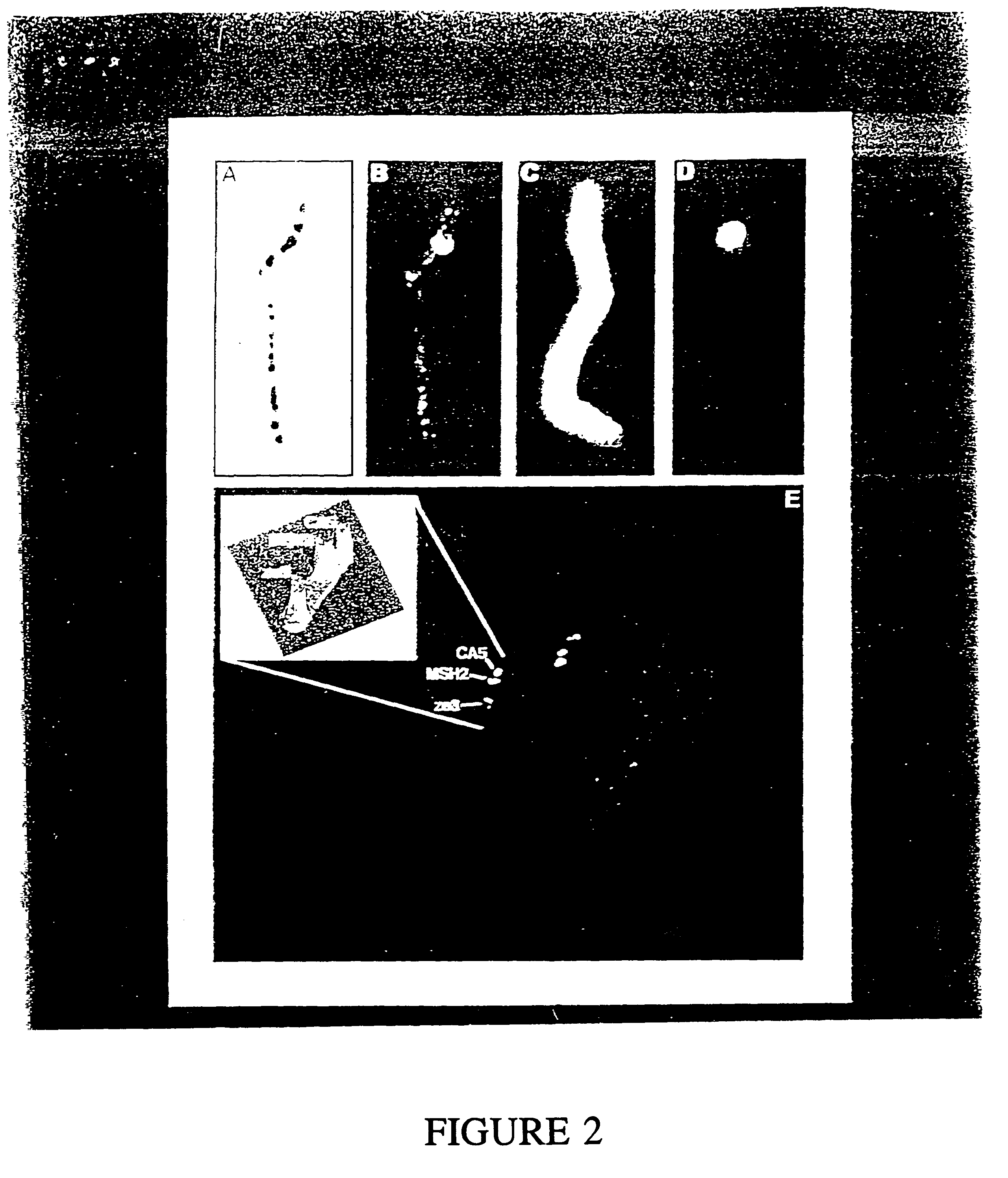Mutator gene and hereditary non-polyposis colorectal cancer
a mutation gene and colorectal cancer technology, applied in the field of mutation gene and hereditary non-polyposis colorectal cancer, can solve the problems that the role of heredity in its causation remains difficult to define, and achieve the effect of preventing the accumulation of somatic mutations
- Summary
- Abstract
- Description
- Claims
- Application Information
AI Technical Summary
Benefits of technology
Problems solved by technology
Method used
Image
Examples
example 1
Somatic Cell Hybrids
[0050]A panel of human-hamster, human-mouse, and human-rat hybrid cell lines was developed to facilitate HNPCC mapping. Hybrids containing only portions of chromosome 2 were obtained by microcell-mediated chromosome transfer or by standard cell fusions following X-irradiation of the chromosome 2 donor. Additionally, two hybrids were used which contained a (X;2)(q28;p21) translocation derived from human fibroblasts. In previous studies, the HNPCC locus was mapped to the 25 cM region surrounding marker 123 and bordered by markers 119 and 136 (Peltomaki et al., 1993a). Thirty-eight hybrids were screened with these three chromosome 2p markers. Eight of the hybrids proved useful for mapping the relevant portion of chromosome 2p. For example, hybrids L1 and L2 contained the distal half of the region, including marker 123, while hybrid y3 contained the half proximal to marker 123 (FIG. 1).
Methods
[0051]Methods for the derivation of microcell-mediated chromosome 2 hybrids...
example 2
Polymorphic Markers
[0052]To map more finely the HNPCC locus, additional polymorphic markers were obtained in three ways. First, a genomic clone containing 85 kb surrounding the 123 marker was used for fluorescence in situ hybridization (FISH) to localize it to chromosomal band 2p16.3 (FIGS. 2A,B). The 2p16 band region was then microdissected, and the sequences within this band were amplified using the polymerase chain reaction and subcloned into plasmid vectors (see Experimental Procedures). The accuracy of the microdissection was confirmed using dual-color FISH by simultaneously hybridizing to microdissected material and a genomic clone containing marker 123 (FIGS. 2C,D). The subclones were screened by hybridization to a (CA)15 probe, and hybridizing clones identified and sequenced. These sequences were then used to design oligonucleotide primers for PCR analysis of genomic DNA. Nineteen (CA)n repeat markers were identified in this way. Of these, four were highly polymorphic and ma...
example 3
Genomic Clones
[0055]Many of the polymorphic markers shown in Table 1 were used to derive genomic clones containing 2p16 sequences. Genomic clones were obtained by PCR screening of human P1 and YAC libraries with these polymorphic markers, with ten additional sequence tagged sites (STS) derived from chromosome 2p16 microdissection, or with YAC junctions. Twenty-three P1 clones, each containing 85-95 kb, were obtained, as well as 35 YAC clones, containing 300 to 1800 kb. The YAC clones in some cases confirmed the linkage and somatic cell hybrid maps. For example, markers ze3 and yh5 were both found in YAC's 4F4 and 1E1 while CA16 and CA18 were both found in YAC 8E5, documenting their proximity. The highest density of genomic clones (28 YAC and 17P1 clones) was obtained between markers yb9 and yh5 (Table 1), which became the region most likely to contain the HNPCC gene during the course of these studies. The region between yh5 and yb9 was predicted to contain ˜9 Mb (assuming 1 Mb / per c...
PUM
| Property | Measurement | Unit |
|---|---|---|
| polymorphic | aaaaa | aaaaa |
| distances | aaaaa | aaaaa |
| image processing | aaaaa | aaaaa |
Abstract
Description
Claims
Application Information
 Login to view more
Login to view more - R&D Engineer
- R&D Manager
- IP Professional
- Industry Leading Data Capabilities
- Powerful AI technology
- Patent DNA Extraction
Browse by: Latest US Patents, China's latest patents, Technical Efficacy Thesaurus, Application Domain, Technology Topic.
© 2024 PatSnap. All rights reserved.Legal|Privacy policy|Modern Slavery Act Transparency Statement|Sitemap



